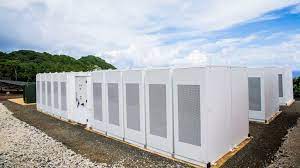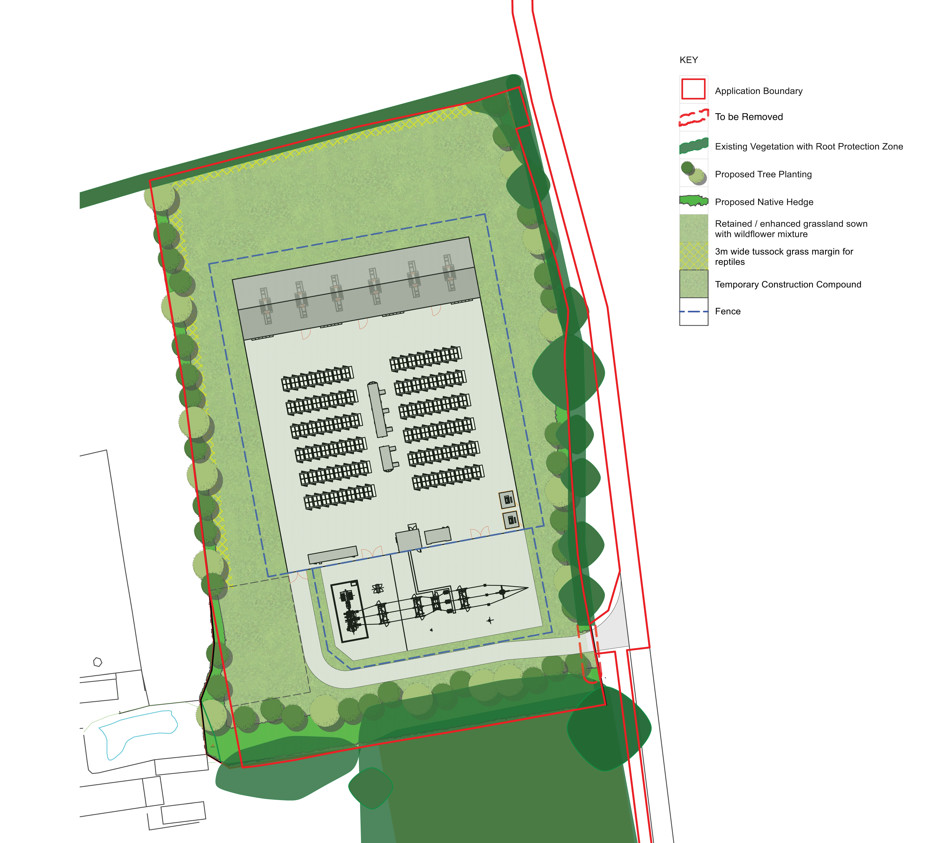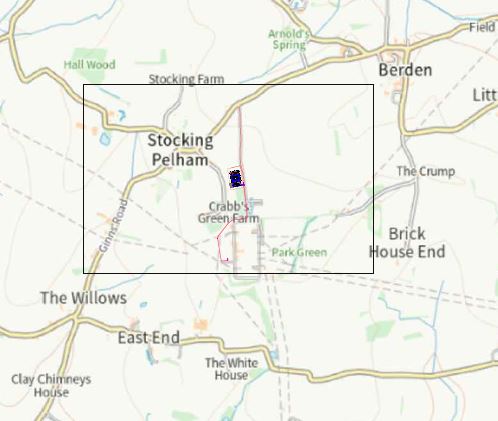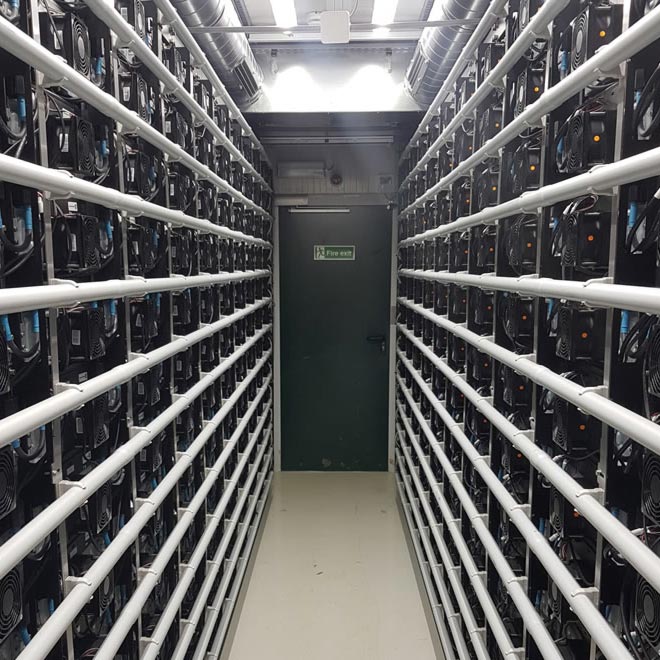Latest News: Renewable Connections has now submitted a planning application to East Hertfordshire Borough Council for our proposed Battery Storage site Crabbs Green. You can see the application that was submitted to the Borough Council with the reference: UTT/22/1203/FUL
CRABBS GREEN
BATTERY STORAGE
Renewable Connections is investigating the potential for a 50MW Battery Energy Storage System (BESS) near Stocking Pelham, Hertfordshire. Once operational, the BESS will enable energy from renewables such as solar and wind to be stored and released when customers need power the most. This will help to tackle the climate emergency in East Herts by increasing the utility and reliability of renewable energy sources, allowing such sources to comprise a larger part of the local energy mix.
- Battery storage has a key role to play in ensuring homes and businesses can be powered by renewable energy sources, even when the sun isn’t shining or when the wind isn’t blowing.
- Batteries help to manage the peaks and troughs of energy demand, supporting a more stable and reliable national electricity grid that is capable of delivering the transition to decarbonised transport and heating needed to meet the country’s net zero goals.
- The UK Government estimates that the implementation of battery energy storage systems could save the UK energy system up to £40 billion in operating costs by 2050, which will help to reduce individual energy bills
We welcome any feedback you wish to provide so please do get in touch.
LOCATION
The site being considered for the Crabbs Green Battery Storage is land off Crabbs Lane in, East Hertfordshire.
The site is situated on an enclosed field of approximately 4 acres currently used as a horse paddock. The field is enclosed by hedgerows, hedgerow trees and tree belts, and the site will note be visible in the wider landscape due to intervening landform.
The site was identified because is close to the National Grid Pelham substation and is well screened. As a consequence, there is limited views of the site from local communities and nearby properties, and it also benefits from being close to a viable grid connection.

OUR PROPOSALS
Once consented and installed, the BESS would provide storage for up to 50MW of electricity and will be operational for up to forty years. After that time, the installation will be removed in its entirety and the land will be restored to its previous use as a storage yard. The electrical inverters on site will be stored within an agricultural style barn to remain in-keeping with the surrounding and to minimise potential noise effects.
The Crabbs Green battery will include state-of-the-art Lithium Iron Phosphate (LFP) battery technology, comprising battery storage modules aligned in rows supported by transformer and inverter platforms. The maximum height of the battery storage modules will be less than 3m.
The transformer and inverter platforms will be connected via underground cables, as will the point of connection to the existing substation. A 2m high perimeter security fence will enclose the site, and will include free-standing CCTV cameras with infrared lighting pointing inwards towards the site only to ensure the safety and protection of the BESS equipment.
PROJECT TIMELINE
STAGE 1
Site selection
Autumn 2020
STAGE 2
Preliminary Surveys
Winter 2020 / Spring 2021
STAGE 3
Pre-application
Summer / Winter 2021
STAGE 5
Submission
Spring 2022
STAGE 6
Construction
Late 2023 / Early 2024
THE NEED FOR THE PROJECT
Following the Government’s declaration of an “Environment and Climate Emergency” in May 2019, the Committee on Climate Change (CCC) advised that to meet ‘Net Zero’ targets, the UK will require substantial amounts of new, low carbon power sources to be built before 2050, up to four times that of today’s levels. Energy storage systems are essential for achieving these goals and National Grid estimates that over 100 GWh of energy storage will be required to meet UK’s net zero target by 2050. There are currently approximately 4 GWh.
Battery storage, together with renewable energy generation help support this target of 50% of energy for the UK’s heat, transport, and electricity consumption to be supplied from renewable sources by 2030.
Renewable energy generation is intermittent and hard to predict due to the fluctuations of wind and solar. Intermittent renewable energy is challenging because it disrupts the conventional methods for planning the daily operation of the electricity grid. Fast fluctuation in wind and solar energy disrupts the balance between total energy supply and demand. BESS’s can react rapidly to sudden changes in the electricity supply and demand securing the stability of the network.
FAQ’s
How do battery energy storage systems work?
Battery Energy Storage Systems (BESS) can be charged by electricity generated from renewable energy, such as wind and solar power, which only produce energy under certain conditions. BESS use intelligent software to co-ordinate energy production and to decide when to store or release energy to the national grid to meet peak demand. This improves the stability of the grid network and allows stored renewable energy to be used even when the conditions for generation are not being met.
Why not use nuclear power instead of battery storage?
Whilst nuclear power stations are able to generate a large and consistent amount of electricity for baseload operation, they are very expensive to build and operate and are unable to react quickly to fast-changing grid fluctuations. On the other hand, BESS is able to respond to changes in the grid quickly and makes it possible for cheap renewable energy to be used during times when it wouldn’t normally be possible. For this reason, to improve the stability of the grid network and to facilitate the transition to net zero it makes more sense to invest in BESS rather than nuclear power.
Why this location?
This site has been identified following an extensive site selection process which considered environmental designations, local electricity network access and capacity, the physical characteristics of the site, and the need for a supportive landowner.
Will there be any permanent impact?
No – the Crabbs Green BESS would operate for a period of up to 40 years, following which the site would be fully decommissioned and returned to its pre-existing use as pasture.
Do batteries pose a health risk?
No – the Lithium Iron Phosphate (LFP) batteries that would be used in the Crabbs Green BESS are thermally and chemically stable, with no risk of fumes or gas leaks. LFP batteries are made of abundant, non-toxic materials like iron, copper, and graphite so also have a lower environmental impact from mining, processing, and recycling when compared to other battery types.
Are the batteries noisy?
The Crabbs Green BESS will generate some electrical noise from the inverter, switchgear, and fan equipment. In order to ensure that the noise from the facility will not have an adverse impact on nearby residential receptors, a number of mitigation measures have been proposed including acoustic screening and a barn structure to house the noisy equipment. A Noise Impact Assessment has been submitted with the planning application to demonstrate noise levels will be below acceptable thresholds.
Are the batteries safe?
The battery storage modules are designed to have a very low risk of failure, and an even lower risk that any failure would result in a fire. In the unlikely event that a fire does occur, both fire detection and fire prevention equipment is installed in all the battery storage modules to ensure that any fires remain under control. All modules will also be equipped with an inert gas suppression system designed to extinguish any fires that are detected by the monitoring system.
GET IN TOUCH
crabbsgreen@renewableconnections.co.uk
Telephone: 0800 254 5011
Crabbs Green Battery Storage
LDN:W,
3 Noble Street,
London,
EC2V 7EE
Renewable Connections is committed to respecting your privacy and to complying with UK data protection and privacy laws. Our privacy policy explains how we collect, use, share and protect personal information.


